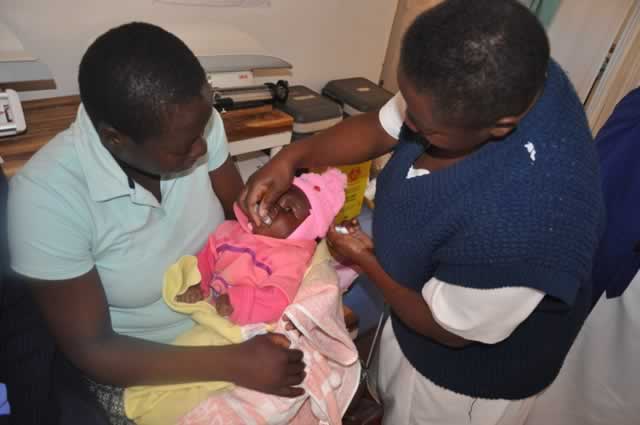Goodbye to home births


A nurse immunises a child at at Bvukururu Rural Health Centre. The facilities at the clinic have been a welcome relief for expecting mothers
Sydney Kawadza Senior Features Writer
The Health Transition Fund (HTF) supports efforts to mobilise resources for critical interventions for the health sector while increasing access to care through eliminating payment of user fees for mothers and children under five.
On June 10 this year, Anyway Mawunze delivered her second baby.
But the birth was different for the young mother who had her first child at home.
The 22-year-old mother from Gambura Village in Chief Gudo’s area of Chiredzi gave birth to her bouncing baby girl at St Joseph’s Clinic in Chiredzi district.
“I had my first child at home partly because I miscalculated my expecting dates and I never bothered to visit the prenatal clinic.
“My first born was delivered by a traditional midwife but after registering with the clinic for the second birth I am convinced that the conditions I delivered in then were not conducive for child birth.
“All expecting mothers should go to the clinic and take advantage of the services offers. It is also safe to deliver at a health institution because home births are a recipe for disaster,” Mawunze said.
Mawunze’s epiphany is shared by many Zimbabwean women who have been wooed by the improved health services and facilities after the challenges faced in the sector during the economic downturn that hit the country at the turn of the century.
The economic challenges severely affected health centres especially in rural areas.
The health delivery system faced near collapse due to severe deterioration in infrastructure, lack of investment, low wages, decreasing motivation and capacity of the civil service, and absolute shortage of essential supplies and commodities
The introduction of the Health Transition Fund in 2012 saw services returning to normal and restoring confidence in Zimbabwe’s health delivery system.
The HTF is a multi-donor pooled fund, managed by UNICEF, to support the Ministry of Health and Child Care in Zimbabwe.
The fund aims at achieving planned progress towards “achieving the highest possible level of health and quality of life for all Zimbabweans”.
The HTF supports efforts to mobilise resources for critical interventions for the health sector while increasing access to care through eliminating payment of user fees for mothers and children under five.
The HTF focuses on four core thematic areas, which are maternal, new born and child health and nutrition; medical products, vaccines and technologies (medicines and commodities); human resources for health (including health worker management, training and retention scheme); and health policy, planning and finance (health services fund scheme and research).
The fund has to date disbursed $158 million.
However, in 2014, the HTF steering committee introduced a results-based financing model to cover 42 rural districts, supporting 923 rural health centres and rural health hospitals.
The funding has seen clinics across Zimbabwe recording improved results in the thematic areas.
Zimbabwe has also recorded a decline in post-neonatal mortality rates.
According to the Multiple Indicator Cluster Survey for 2014, post-neonatal mortality rate was estimated at 25 deaths per 1 000 live births in the five years preceding the survey from 2010 to 2014.
The survey indicated that the rate was 33 deaths per 1 000 live births and 31 deaths per 1 000 live births for the 5-9 years and 10-14 years preceding the survey, respectively.
This shows, according to the survey, a stable trend from 31 deaths between 2000 and 2004 to 33 deaths per 1 000 live births between 2005 and 2009 and a decline to 25 deaths per 1 000 live births between 2010 and 2014.
The infant mortality rate declined from 84 deaths per 1 000 live births to 74 deaths per 1 000 births between 2010 and 2014.
In Masvingo, for example, significant improvement has been recorded in the maternal, new-born and child health and nutrition.
Expecting mothers have also hailed the improved services at the clinics.
At Bvukururu Rural Health Centre in Zaka, Mrs Irene Mateya – a mother of five children – testifies to the improved services and facilities at the clinic.
“There was a time when we used to sleep on the floors but the clinic has the necessary equipment to cater for expecting mothers,” she said.
Bvukururu Clinic caters for patients travelling an average of 20 kilometres.
Mavis Maguma (22) lives in Mazunda Village on the border between Zaka and Bikita districts.
She said the waiting mothers’ shelters at clinics had improved their lives.
“Our main challenge was traveling the 20 kilometres from home and this contributed to the high number of home births in the district.
“The facilities at the clinic have been a welcome relief for expecting mothers,” she said.
However, the Bvukururu RHC committee treasurer, Mr Alfios Mutonhodza, said while the HTF has had a significant impact on the clinic, there was need for timeous distribution of the funds.
“We do not rely on financially strained villagers for operational costs but our wish is to get more funding.”
Nurse-in-Charge Sister Familiar Zendera said the number of home deliveries has decreased tremendously.
“We get at least 15 deliveries at the clinic but home births have become quite scarce with at least one in a very long period.”
Zaka district medical officer Dr Morgan Muzondo said the funds have eased pressure on referral hospitals.
“Most clinics have been equipped enough to cater for all primary health care and there is no need to refer cases,” he said.
Dr Muzondo, however, said funds were not enough when they dealt with births through the Caesarian section.
“We have 15-20 births through the Caesarian section which are more expensive so sometimes the money received is not enough to cover the quota.”
Dr Muzondo hailed traditional and political leaders for supporting the HTF and RBF programmes.
In Chiredzi, traditional leaders have gone a step further in support of the programmes.
Women who give birth at home are fined.
Mothers at the waiting shelter at St Joseph’s revealed how they are fined a goat for every home birth.
According to Mrs Patience Mutende (18) of Dhokotera Village in Ward 24, delivering at the clinic was a prerequisite.
Their traditional leader, Chief Gudo, has ordered the fine for home births.
“I stayed at the waiting shelter for a month because I do not want to be charged. However, they are many advantages to giving birth at the clinic than at home,” Mrs Mutende said.
She, however, urged women to register their pregnancies early.
“The idea is not only giving birth at a safe institution but there is also the education given by nurses that helps even after giving birth.”
Sister Anna Musara, the nurse-in- charge at St Joseph’s, said the clinic abolished all user fees for mothers and infants under five years after receiving $12 000.
“We have added more equipment for our clinic which has seen us improve service in the labour ward. But all in all, the clinic has been electrified and our mothers’ waiting shed can hold up to 25 women per month.”
The clinic offers services to almost 18 000 villagers who walk an average of 40-45 kilometres to the clinic.
“We deliver an average of 30 babies a month with little or no complications. We have seen a tremendous reduction in neo-natal and infant mortality rates after receiving funding,” she said.
Masvingo provincial medical director Dr Robert Mudyiradima said the challenges faced in the health sector especially in the 2008-2009 period were too heavy for Government to go it alone.
“We faced a lot of challenges as a country and in Masvingo, the staff was demotivated that we could not ensure proper service delivery.
“There were also shortages of medicine even to provide primary health care but the funding provided a welcome alternative for our health delivery system,” he said.
Dr Mudyiradima, however, felt there was too much concentration on maternal health.
“We hope that the funding is increased so that it is expanded to other services. The challenge is that people are now neglecting other patients and we get a very satisfied mother and child while other services are lagging behind,” he said.
The HTF aims to help medical facilities to meet non-salary recurrent costs, such as utilities, fuel and outreach in order to strengthen national health systems.
The RBF rollout focuses on building sustainability through building the capacity of the MOHCC by, for example, having community health sisters undertaking first level verification and health information officers who validate data with the district health executives.
Feedback: [email protected]








Comments